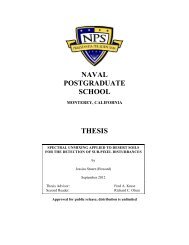October 2000 Newsletter - Naval Postgraduate School
October 2000 Newsletter - Naval Postgraduate School
October 2000 Newsletter - Naval Postgraduate School
You also want an ePaper? Increase the reach of your titles
YUMPU automatically turns print PDFs into web optimized ePapers that Google loves.
The organizational relationship regarding the technical and<br />
research assistance provided by the <strong>Naval</strong> <strong>Postgraduate</strong> <strong>School</strong><br />
(NPS) in support of the Joint Battle Center Mission was formalized<br />
by a Memorandum of Understanding between NPS<br />
and the Joint C4ISR Battle Center.<br />
The Joint C4ISR Battle Center (JBC) is responsible for conducting<br />
assessments of issues related to fielding Joint C4ISR<br />
systems, including methods for achieving interoperability<br />
within a C4ISR “system of systems” composed of both legacy<br />
and developmental C4ISR systems. JBC provides reports to<br />
the Joint Requirements Oversight Council (JROC) with recommendations<br />
regarding such issues. NPS has expertise on<br />
many system-related issues and access to students from all<br />
branches of DoD with expertise on military issues. The purpose<br />
of this agreement is to establish a procedure for identifying<br />
and funding projects to be carried out by NPS that contribute<br />
to the mission of JBC.<br />
The JBC is staffed by Warfighters, C4ISR subject matter<br />
experts, and technologists. It is an organization which<br />
brings the Warfighter directly into the assessment process.<br />
The assessment methodology, combined with the organizational<br />
uniqueness of the JBC, lowers barriers between<br />
Warfighters and technologists by creating a powerful<br />
environment for joint operational innovation and<br />
interoperability demonstrations and assessments. To do<br />
this, the JBC provides a re-configurable JTF C4ISR<br />
laboratory/network and assessment environment. In<br />
addition, the JBC is located in close proximity to the Joint<br />
Training Analysis and Simulation Center (JTASC) which<br />
conducts the Unified Endeavor (UE) series of operational<br />
exercises. This proximity and relationship are absolutely<br />
RELATIONSHIPS<br />
TECHNICAL AND RESEARCH ASSISTANCE IN SUPPORT OF THE JOINT C4ISR BATTLE<br />
CENTER<br />
fundamental to the successful execution of the JBC mission<br />
and charter. It is this environment that allows Warfighters<br />
and technologists to see, touch, and feel the C4ISR capabilities<br />
to be used in combat. This environment allows rapid<br />
assessment of JTF- required maturity, interoperability and<br />
utility. It allows the creation of technology insertion<br />
solutions to current JTF problems, and assessment of those<br />
solutions. It creates a venue for the dynamic interaction of<br />
emergent technology with operational doctrine-another<br />
fertile field for technologist/Warfighter collaboration. The<br />
objective of the JBC is to provide a fielded interoperable<br />
capability, meeting the Joint Warfighter’s needs as defined<br />
through the CINC’s requirements process and using<br />
technological advancements on an accelerated basis. The<br />
JBC identifies systems that clearly demonstrate joint “value<br />
added” for potential rapid fielding. Systems that do not<br />
demonstrate joint interoperability may be recommended for<br />
either improvement or elimination.<br />
NPS has academic experts responsible for providing<br />
advanced education and conducting research in many<br />
related areas. NPS is one of the leading centers of excellence,<br />
which has won numerous research awards and has<br />
pioneered the establishment of Engineering Ph.D. programs<br />
in the U.S. NPS has many M.S. and Ph.D. students who<br />
are eager to conduct thesis research that contributes to the<br />
DoD and the mission of JBC.<br />
The principal objective of this agreement is to establish a<br />
direct relationship between NPS and JBC for mutual cooperation<br />
and benefit. It will provide a mechanism by which<br />
M.S. and Ph.D. students and faculty can conduct research<br />
that contributes to the DoD and the mission of JBC.<br />
SUBMARINE TACTICAL DEVELOPMENT SUPPORT BY NPS<br />
A Memorandum of Understanding formalized the relationship between the <strong>Naval</strong> <strong>Postgraduate</strong> <strong>School</strong> (NPS) and<br />
Submarine Development Squadron Twelve (SUBDEVRON TWELVE). The goal of this relationship is to take<br />
advantage of the Navy’s unique academic institution at NPS, leveraging their expertise in Operations Research and<br />
Undersea Warfare (USW) disciplines to increase the Submarine Force’s combat effectiveness. Through the NPS<br />
faculty, students will be encouraged to pursue thesis work on projects that will benefit Submarine Force tactical<br />
development. Additionally, NPS’ expertise in technological change and innovation, statistical modeling, algorithm<br />
development, and their evaluation of emerging technologies will be sought out for USW applications. Finally, NPS<br />
graduate students will be exposed to SUBDEVRON TWELVE’s mission, with the prospect for a follow on staff<br />
tour.<br />
NPS Research page 26<br />
<strong>October</strong> <strong>2000</strong>
















